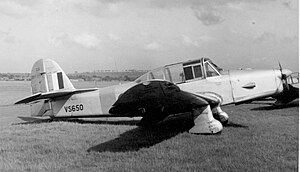Percival Prentice
| Prentice | |
|---|---|
 |
|
| A Percival P.40 Prentice T.1 of No. 16 Reserve Flying School based at Derby (Burnaston) Airport in service in May 1953 | |
| Role | Military trainer aircraft |
| Manufacturer | Percival |
| First flight | 31 March 1946 |
| Introduction | November 1947 |
| Retired | 1953 |
| Primary users |
Royal Air Force Argentine Air Force private pilot owners after disposal by the RAF |
| Produced | 1947-1949 |
| Number built | >370 |
The Percival Prentice is a basic trainer of the Royal Air Force in the early postwar period. It was a low-wing monoplane with a fixed tailwheel undercarriage. Front seating was in a side-by-side configuration with a rear seat provided.
Designed to meet Air Ministry Specification T.23/43, the Prentice was the first all-metal aircraft to be produced by the Percival Aircraft Company. The prototype Prentice TV163 first flew from Percival's factory at Luton Airport, Bedfordshire on 31 March 1946. Early trials revealed inadequate rudder control, resulting in a revised rudder and a large cutout in the elevators. The aircraft were later modified with turned-up wingtips. Over 370 were delivered to the RAF between 1947 and 1949.
An unusual design feature was the provision for three seats. While the instructor and pupil were equipped with dual controls in a side-by-side arrangement in the front, a second pupil sat in the rear seat without controls to receive "air experience". Both pupils could communicate with the instructor. Night flying training was to be carried out in daylight by means of amber screens incorporated into the canopy and the use of special goggles. The amber screens were folded back when not in use.
Several hundred Prentices were ordered for RAF use. Since the Percival factory was concentrating on production of the Percival Proctor and the Merganser light transport aircraft, production was sub-contracted to the Blackburn Aircraft works at Brough.
After these modifications, the Prentice was passed into RAF service, initially with the regular Flying Training Schools (FTS) including the RAF College, Cranwell where they replaced the remaining de Havilland Tiger Moths. Later deliveries went to the Reserve Flying Schools (RFS). The type was used as a pilot trainer until 1952 at the RAF College where it was replaced by the de Havilland (Canada) Chipmunk and in late 1953 at the other schools, when it was replaced by the Percival Provost. Two Air Signals Schools also operated the type to train air signallers, until the last were withdrawn from No.1 ASS at RAF Swanton Morley, Norfolk, in mid 1956.
...
Wikipedia
